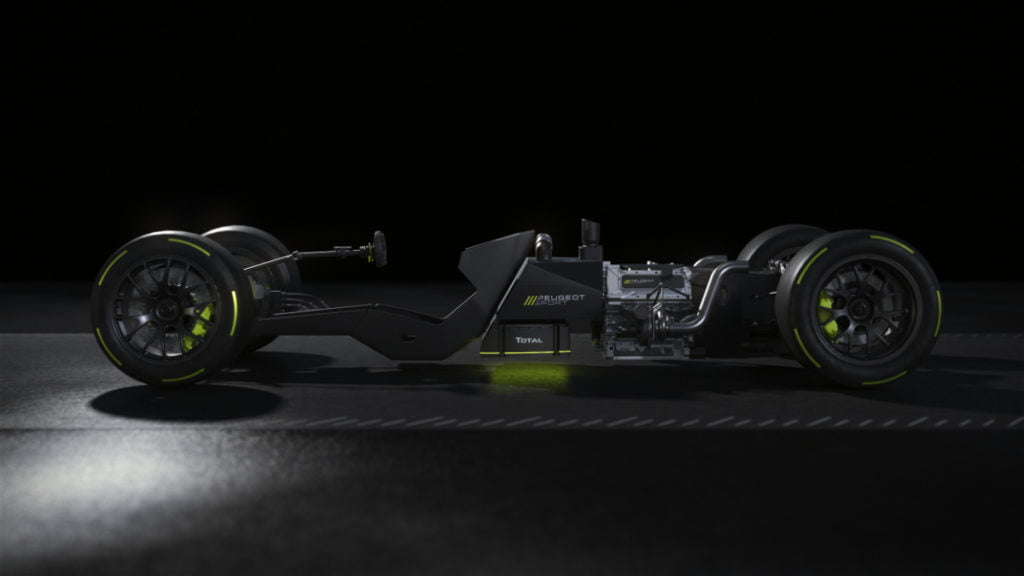Peugeot has unveiled the powertrain for its Le Mans Hypercar, with which it will enter the 2022 FIA World Endurance Championship and 24 Hours of Le Mans.
The powertrain, which the French manufacturer has named the PEUGEOT HYBRID4 500KW, consists of a rear-engined, 2.6 litre twin turbo V6 engine producing 500 kW (680 horsepower), combined with a front-mounted 200 kW motor generator unit.
Additionally, the car will have a four-wheel drive transmission and sequential seven-speed gearbox and a high power-density battery system developed in collaboration between Peugeot Sport, Total and subsidiary Saft.
“The architecture of the PEUGEOT HYBRID4 500KW powertrain is the result of a highly-detailed brief shaped by the new FIA WEC regulations,” notes François Coudrain, Peugeot Sport’s WEC Program Powertrain Director.
“We initially considered a single turbo, but that would have prevented us from achieving our engine’s centre of gravity target.”
“A twin-turbo V6 block offers the best trade-off between technology, weight, packaging of the engine’s ancillaries, reliability and performance.”
According to Peugeot, the car’s front-mounted motor generator will benefit from the manufacturer’s ‘ experience of developing electric motors and management systems for production cars.’
“The motor generator unit will be equipped with a lightweight, high-efficiency single-speed transmission and a latest-generation inverter to transfer battery power to the motor,” says Coudrain. “It will have the capacity to use all the energy available in the battery instantly thanks to the powertrain’s energy management system strategies.
“PSA Motorsport’s experience of the WRC and Formula E will contribute to the development of the software employed to manage the computer and energy systems [braking energy recovery, power under acceleration, anti-lag system, reduced fuel-consumption].”
The electric motor will produce 200 kW, which is the maximum available output under the WEC’s regulations. Additionally, the regulations state that the electric motor may not be used when the car is travelling below 120 kph.
The 900-volt high-density battery, developed by Total subsidiary Saft, completes the powertrain. The battery will be located in a carbon casing inside the monocoque, behind the driver and underneath the fuel tank.
The battery will be full charged prior to the race through a plug-in hybrid system, but once the race has started, the battery will be charged through regenerative braking.
While the battery was developed by Saft, it will be homologated and produced by Peugeot Sport and Total at a new workshop at Peugeot’s French base at Versailles-Satory.
At full power, the V6 engine will be capped at 300 kW (408 hp) to compensate for the MGU’s 200 kW output. The engine will then revert to the full 500 kW (608 hp) power out once the battery level lowers.
An exception to this system comes when the car nears the end of a straight and the battery is empty, at which point the engine capacity may be increased by three percent to 515 kW (700 hp), so that the electric motor is working as 15 kW electric motor.
When the MGU unit becomes active, the car switches to four-wheel driver, while it reverts back to rear-wheel drive once the battery becomes empty.
“The main parameter will be to optimise how the energy stored in the battery is used,” explains Kamen Nechev, Saft’s Chief Technology Officer. “To achieve this, you need an extremely short charge-time combined with high-capacity storage cells to form a package that enables maximum power to be delivered as rapidly as possible.
“The most competitive solution resides in the management of charge optimisation and the amount of power available in real time.”
Peugeot expects to begin on-track testing at the end of 2021, before it joins the championship in 2022. Toyota, the other major manufacturer building a Le Mans Hypercar, will unveil its car in January ahead of its March 2021 WEC debut.












